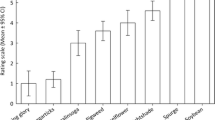Abstract
In laboratory studies on the nymphal and adult performance of the cotton Stainers Dysdercus cardinalis and D. fasciatus (Pyrrhocoridae: Hemiptera) on seeds of five different host plants, two categories of hosts with significantly (P < 0.05) different biological effects were identified. Gossypium hirsutum L., Ceiba pentrandra Gaertn and Sterculia rhynchocarpa (K. Schum) were found to be suitable hosts (category A) while Adansonia digitata L. and Abutilon mauritianum (Jacq. Medic.) were unsuitable (category B). Category A hosts that grew in the wild appear to serve as perennial breeding reservoirs for the cotton Stainers and thus play a significant role in initiating and perpetuating their infestation of adjacent cotton crops. The converse appears to be true for category B hosts, whose long-term effect would be to gradually decrease the population of the cotton stainers.
Résumé
Au cours des essais de laboratoire portant sur la performance des stades nymphaux et adultes des punaises du cotonnier, Dysdercus cardinalis et D. fasciatus (Hemiptera: Pyrrhocoridae) sur les graines de cinq différentes plantes-hôtes, on a identifié deux catégories d’hôtes avec des effets biologiquement significatifs (P < 0,05). Gossypium hirsutum L., Ceiba pentrandra Gaertn et Sterculia rynchocarpa (K. Shum) se sont montrés comme étant des plantes-hôtes appropriées (Catégorie A), au moment où Adansonia digitata L. et Abutilon mauritianum (Jacq. Medic. Jetaient inappropriés (Catégorie B). Les plantes-hôtes de la catégorie A qui poussaient à l’état sauvage semblent constituer des réservoirs permanents de reproduction pour les punaises du cotonnier. Ces plantes jouent un rôle impotant lors de l’initiation et la perpétuation des dégâts infligés par les punaises, aux cultures adjacentes au cotonnier. L’inverse semble aussi être vrai pour les plantes-hôtes de la catégorie B dont l’effet à long terme servirait à faire baisser graduellement la population de punaises.
Similar content being viewed by others
References
Bebbington A. G. and Allan W. (1936) The food cycle of Dysdercus fasciatus in Acacia savannah in Northern Rhodesia. Bull. Ent. Res. 27, 237–249.
Bohlen E. (1978) Crop Pests in Tanzania and Their Control. Verlag Paul Parey, Berlin, Hamburg. 142 pp.
Cowland J. W. and Ruttledge W. (1927) Notes on cotton stainers (Dysdercus) in the Sudan. Bull. Ent. Res. 18, 159–163.
Crowe T. J. (1971) Cotton Pests and Their Control. Dept. of Agrie. Kenya. 124 pp.
Encamacion D. J. (1970) Biology of cotton stainer, Dysdercus cingulatus F. (Pyrrhocoridae: Hemiptera). Phillip. Entomol. 1, 341–349.
Hill D. S (1975) Agricultural Insects of the Tropics and Their Control. Cambridge University Press, London. 516 pp.
Hodkinson T. D. and Hughes M. K. (1982) Outline studies in ecology. In Insect Herbivores. Academic Press, New York. 11 pp.
La Croix E. A. S. (1966) Stainer bugs (Dysdercus spp.) in Coast Province, Kenya. Emp. Cot. Rev. 43, 41.
Le Pelley R. H. (1959) Agricultural Insects of East Africa. E.A. High Commission, Nairobi, Kenya. 307 pp.
Little M. and Hills J. F. (1975) Statistical Methods in Agricultural Research. University of California, Davis. 95616, 93–102.
Pearson E. O. (1958) The Insect Pests of Cotton in Tropical Africa. Commonwealth Institute of Entomology, London. 350 pp.
Schmutterer H. (1969) Pests of Crops in Northeast and Central Africa. Gustav. Fischer Verlag, Stuttgart, pp. 66–72.
Whitfield F. G. S. (1933) The bionomics and control of Dysdercus (Hemiptera) in Sudan. Bull. Ent. Res. 24, 301–313.
Author information
Authors and Affiliations
Rights and permissions
About this article
Cite this article
Chemengich, B.T., Khaemba, B.M. Comparative Studies on Biological Performance of the Cotton Stainers Dysdercus cardinalis Gerst and Dysdercus fasciatus Signoret Bred on Different Hosts. Int J Trop Insect Sci 18, 25–29 (1998). https://doi.org/10.1017/S1742758400007426
Accepted:
Published:
Issue Date:
DOI: https://doi.org/10.1017/S1742758400007426




